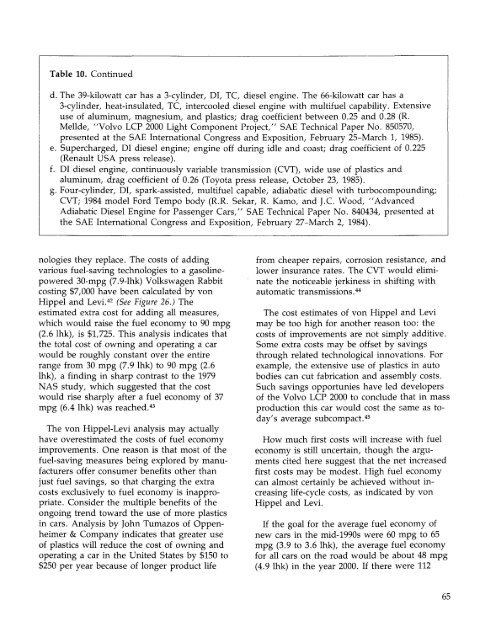ENERGY FOR A SUSTAINABLE WORLD - World Resources Institute
ENERGY FOR A SUSTAINABLE WORLD - World Resources Institute
ENERGY FOR A SUSTAINABLE WORLD - World Resources Institute
You also want an ePaper? Increase the reach of your titles
YUMPU automatically turns print PDFs into web optimized ePapers that Google loves.
Table 10. Continued<br />
d. The 39-kilowatt car has a 3-cylinder, DI, TC, diesel engine. The 66-kilowatt car has a<br />
3-cylinder, heat-insulated, TC, intercooled diesel engine with multifuel capability. Extensive<br />
use of aluminum, magnesium, and plastics; drag coefficient between 0.25 and 0.28 (R.<br />
Mellde, "Volvo LCP 2000 Light Component Project," SAE Technical Paper No. 850570,<br />
presented at the SAE International Congress and Exposition, February 25-March 1, 1985).<br />
e. Supercharged, DI diesel engine; engine off during idle and coast; drag coefficient of 0.225<br />
(Renault USA press release).<br />
f. DI diesel engine, continuously variable transmission (CVT), wide use of plastics and<br />
aluminum, drag coefficient of 0.26 (Toyota press release, October 23, 1985).<br />
g. Four-cylinder, DI, spark-assisted, multifuel capable, adiabatic diesel with turbocompounding;<br />
CVT; 1984 model Ford Tempo body (R.R. Sekar, R. Kamo, and J.C. Wood, "Advanced<br />
Adiabatic Diesel Engine for Passenger Cars," SAE Technical Paper No. 840434, presented at<br />
the SAE International Congress and Exposition, February 27-March 2, 1984).<br />
nologies they replace. The costs of adding<br />
various fuel-saving technologies to a gasolinepowered<br />
30-mpg (7.9-lhk) Volkswagen Rabbit<br />
costing $7,000 have been calculated by von<br />
Hippel and Levi. 42 (See Figure 26.) The<br />
estimated extra cost for adding all measures,<br />
which would raise the fuel economy to 90 mpg<br />
(2.6 Ihk), is $1,725. This analysis indicates that<br />
the total cost of owning and operating a car<br />
would be roughly constant over the entire<br />
range from 30 mpg (7.9 Ihk) to 90 mpg (2.6<br />
Ihk), a finding in sharp contrast to the 1979<br />
NAS study, which suggested that the cost<br />
would rise sharply after a fuel economy of 37<br />
mpg (6.4 Ihk) was reached. 43<br />
The von Hippel-Levi analysis may actually<br />
have overestimated the costs of fuel economy<br />
improvements. One reason is that most of the<br />
fuel-saving measures being explored by manufacturers<br />
offer consumer benefits other than<br />
just fuel savings, so that charging the extra<br />
costs exclusively to fuel economy is inappropriate.<br />
Consider the multiple benefits of the<br />
ongoing trend toward the use of more plastics<br />
in cars. Analysis by John Tumazos of Oppenheimer<br />
& Company indicates that greater use<br />
of plastics will reduce the cost of owning and<br />
operating a car in the United States by $150 to<br />
$250 per year because of longer product life<br />
from cheaper repairs, corrosion resistance, and<br />
lower insurance rates. The CVT would eliminate<br />
the noticeable jerkiness in shifting with<br />
automatic transmissions. 44<br />
The cost estimates of von Hippel and Levi<br />
may be too high for another reason too: the<br />
costs of improvements are not simply additive.<br />
Some extra costs may be offset by savings<br />
through related technological innovations. For<br />
example, the extensive use of plastics in auto<br />
bodies can cut fabrication and assembly costs.<br />
Such savings opportunies have led developers<br />
of the Volvo LCP 2000 to conclude that in mass<br />
production this car would cost the same as today's<br />
average subcompact. 45<br />
How much first costs will increase with fuel<br />
economy is still uncertain, though the arguments<br />
cited here suggest that the net increased<br />
first costs may be modest. High fuel economy<br />
can almost certainly be achieved without increasing<br />
life-cycle costs, as indicated by von<br />
Hippel and Levi.<br />
If the goal for the average fuel economy of<br />
new cars in the mid-1990s were 60 mpg to 65<br />
mpg (3.9 to 3.6 Ihk), the average fuel economy<br />
for all cars on the road would be about 48 mpg<br />
(4.9 Ihk) in the year 2000. If there were 112<br />
65

















